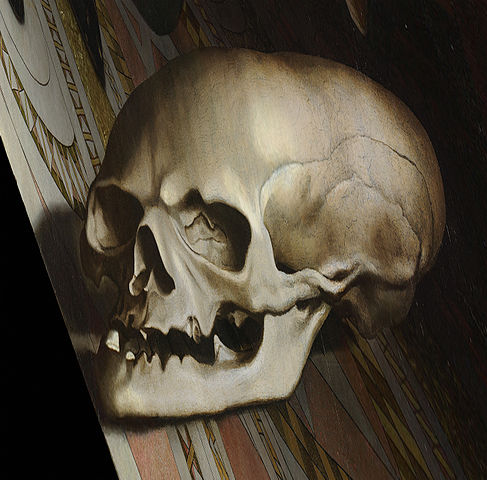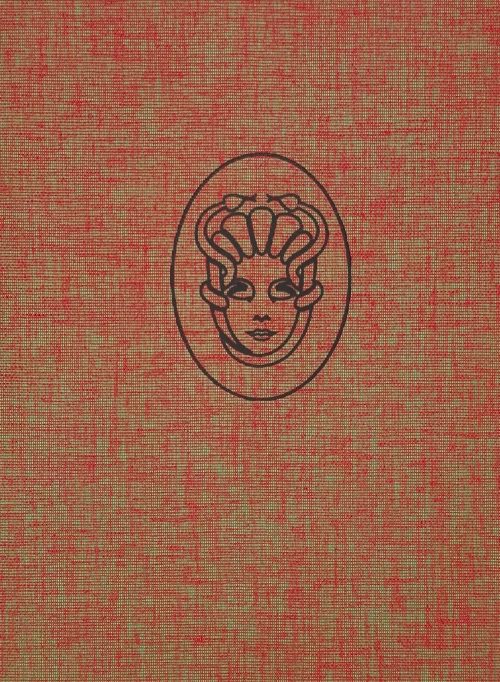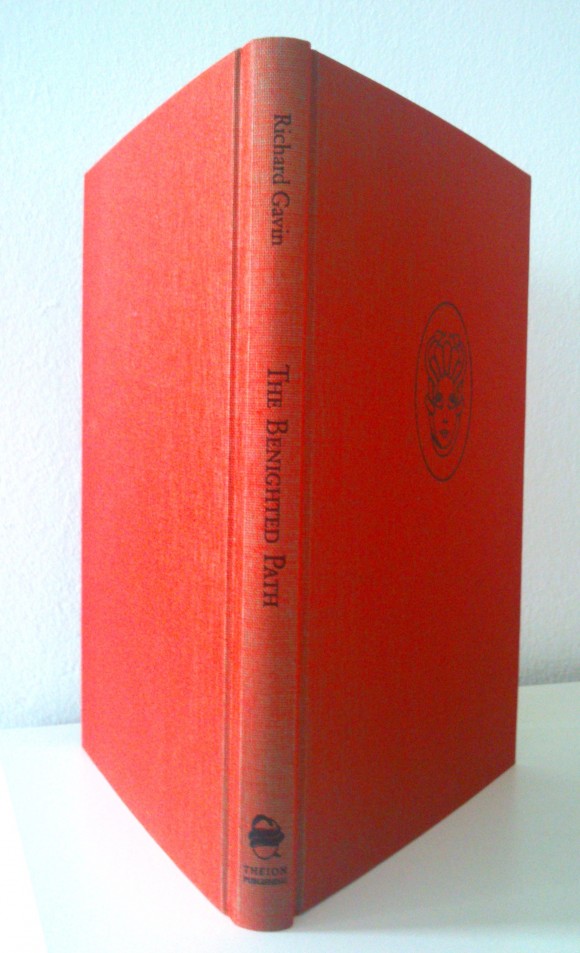As an unconventional tome, The Benighted Path by Richard Gavin, ed. David Beth (Munich: Theion Publishing, 2015) does not readily accede to a typical review, not at least in the general accepted sense. A review implies encapsulation. Rather than attempt to reduce this project I will merely touch on a few salient features as they came to the forefront of my encounter with its force and significance. BP is a project, and a tool; a guide for qliphothic endeavor. But how it operates as a magickal work depends upon the viewer’s vantage point. Upon receiving a copy I was reminded of Holbein the Younger’s The Ambassadors,

wherein amongst other things, a skull is obscured in plain view through the skillful employment of the ars perspectiva. According to Alberti, through the careful placement of objects within a visual grid certain things may be concealed as well as highlighted and brought to the foreground. By standing at an oblique angle to The Ambassadors the skull becomes clearly visible.

In a similar fashion the cover of the standard edition of BP viewed straight on appears as an olive green mottled red adorned with an embossed medusa. But when held at an angle the cloth bound cover turns a viridescing crimson blood red. The skull in Holbein’s painting has been labeled as an anamorphic image, meaning, it looks distorted unless viewed from a certain angle and then it appears normal.

I hesitate to even suggest the same applies to BP, aside from the fact that the notion of normal is so highly subjective, because this study is also subject to distortion and easily misunderstood as a whole for anyone who is not in possession of a sublimated perspective and occulted chiaroscuro—a sharply cast sense of form and shadow from within the psyche.

A purely linear or diachronic reading ofBP does the study and oneself a great disservice. Gavin’s work is highly discursive and winds about with subconsciously articulated convolutions in and upon itself constantly pushing the reader’s sense of contiguity to its limits. The work is purposefully suggestive and allusive. This is based on certain assumptions given the author’s own stated presuppositions in BP itself. In the first chapter he claims “The Benighted Path is not a barrier but a seam, pregnant with portents of Becoming.” (p.28) Shortly thereafter he succinctly states that “Cultivation of this seam can only occur through the engagement and arousal of the poetic faculty” which I take simply as the faculty of making. The classical Greek mindset conceived of the poet as a maker, plain and simple.
In short, Gavin’s work calls for an immersion and embodiment in the shadow realms of consciousness to one’s bearable limits and perhaps beyond. That is my sense of the project’s gnosis. It is a system and not altogether similar to typical magical methods which call for a disciplined praxis. BP calls for surrender and possession by the wyrd itself. It is a tall order and in no way a secure endeavor (but then again, any path worth embarking upon is precarious insofar as anything that threatens accepted normalcy on any level is concerned).
The Monstrous Soul is the overriding obsession of this work. In framing it as an obsession I mean this in its most utilitarian way and in its most tenuously uncontrollable aspects as promulgated by Austin Osman Spare. Because surrendering control is a key factor this approach becomes the most daunting task presumed in this tract. I’m reminded of Joel Biroco’s important manifest on Juxtapositional Magick. Biroco’s project is based on the practitioner developing an innate awareness of alignments and juxtaposed elements in their surroundings and consciousness to be harnessed for sigils, spontaneously and without direction. Biroco clearly states that it’s not something anyone can actually consciously construct, these juxtapositions, but foster a level of receptivity that permits them to register with and accentuate one’s psyche. Biroco is explicit in this regard whereas Gavin is implicit in keeping with the overall shadow perspective his work engenders. This lure surfaces in what Gavin refers to as a grammar of decay by focusing on bones, skulls, viscera, explicit momento mori of the most stark and abhorrent as emblems of the absolute shadow of death and its remains.( pp. 127-130). In fact, in a very telling moment we’re informed:
The grammar of the Benighted Path rarely takes the form of human speech (hence the relative concision of this book). Our language is the cawing of the carrion crow, the low whistle of an autumn wind, the raising of hackles, the idiolalia of dream speak. One’s grammar may be babble toall but one’s self.” (pp. 129-130).
Prior to this section the author discusses creating a reliquary of wyrd objects such as bones, etc.. He offers hints but avoids providing much detail about exact usage of these artifacts which at first I found disconcerting until I considered the overall logic. The bones and their implementation are partially concealed / revealed as is Holbein’s skull in The Ambassadors inducing a trial and error of positioning in order to facilitate a revelatory view key to opening perception.
Asserting “the relative concision of this book” surfaces as a somewhat tongue-in-cheek subterfuge but also the work’s very content emerging as an extension of its form or katabasis described therein. Had the author explicitly spelled out recipes and or protracted formulas for implementation then he would, in essence, have been operating in direct contradistinction to a shadow or dream-world mode of logic or anti-logic. Persisting in this fashion would have pulled the rug straight out from under its very foundation in attempting to lay it firmly in place. Static solid ground is pure anathema to the monstrous soul. That’s the beauty and inherent problem of the BP—it is allusive, elusive, and even illusive to a certain extent. The illusion is propagated potentially for readers seeking a definiteness which can never be, never was in the dream-time that is constantly moving ahead, in flux and creative, ie poetic.
The idiolalic, idiosyncratic glossolalia as I take it, or seemingly incoherent enunciations that are endemic to the individual, are central to the practical concerns of the BP. I have come to a similar assessment in my own work by suggesting a grammatography in chapter 4 of The Sacred Alignments and Sigils. Such a systematization, or to be more precise, syntax of graphic formal elements such as line, curve, squiggle, in relation to the aesthetics of sigil formation is only of relevance to the individual. Like components of a dream, the psycho-aesthetics of form are significant to each and everyone insofar as much as dreams hold the same intrinsic sort of worth. To seek out a universal method of decoding such elements is to miss the point altogether. Subsequently I have found myself immersed in the monstrous (w)hole. Given my own proclivities and idiolalizations I find the monstrous dilation transmitting as a whole, akin to Cusa’s concept of the absolute maximum or expansion as it converges eventually into the contracted point; and as a hole, akin to a black hole or an aperture absorbent of all light, in particular, intention’s.
Speaking of a black hole brings us to the central katabatic aspect of the benighted approach: a descent into the underworld for the sake of advancing consciousness. It is an un-harrowing as there is no expressed aim in liberating anything from the depths. Rather, through intentional descent and embodied awareness, the BP zeroes in on multi-faceted dimensions of being dispersed throughout the infinite darkness. The somatic symptoms of the katabasis, arousal and launching of the dreaming body, as an exploratory vehicle of the monstrous soul are thankfully not overlooked. Gavin affords some telling insights concerning the thanatos drive and the psycho-physiology of the dreaming body, that “Kephra’s bodily design is organically etched into our bones.”(p.128) “Along with the arousal of the Qoph, thin bands of pressure along the back of the neck…[are] common symptoms of arousal of the Monstrous Soul.”(p. 56) Bones litter this section of the book hopefully encouraging certain practitioners to adopt parallax views of ossuaries and their subliminal significance. We learn about the “Trance of the Bones” as part and parcel of BP’s “biocentric intent.” This reference to Ludwig Klage’s philosophy of biocentricity in terms of the manic / mantic drive of eros in compelling serious aspirants will no doubt be obvious to those familiar with Klages work (see: Of Cosmogonic Eros, and Chthonic Gnosis both by Theion Press). I am also reminded of William Butler Yeats most magickal play, The Dreaming of the Bones where a young man and woman engage in dialogue over the dead and their dreams, memories, essences that lie still imbued in their bones. Their exchange eventually dissolves in an a-temporal realm where their own history and existences are left wide open to conjecture and further dreaming.
The mention of Jung’s obsession with the katabasis and “granting the unconscious absolute free expression” is noteworthy (p.57). In fact, Peter Kingsley, in his recent book, Catafalque, uncovers much previously unknown information on this topic including Jung’s conversations with Henri Corbin where he revealed that magic and delving deep into the shadow realms of consciousness were his primary concerns to the end. Kingsley points out that Jung often drove himself to the edge of absolute insanity but hid it from his students and colleagues for fear of losing grant money, etc.. It is quite satisfying and encouraging to know that Carl Jung himself took extreme risks in his own benighted quest for expanded awareness. Undoubtedly, the Benighted approach itself is one of extreme risk because katabasis’s aim broaches the unknown and untrodden wastes of primal consciousness where the aspirant is clearly and absolutely on their own having forgone all better waking judgment.
There is much more to say about BP as well as less. The project initiated by this path is one often not readily discernible and chaotic given the best of circumstances wherein intuition may in fact be the only reliable guide.
As I approach my incompletion of this un-review I am inclined toward a few utterances, questions, things approaching observations and nascent formulations.
________________________________________________________
How one random thought fades and another arises
Actions without thinking
Reflections, especially those of shadows in the water pullulate
What does your writing
Gouges in wood meaning
How does sex drive out
of sex
Imagine an object that works its way into the shadows on its own
Cats, just… cats.
_______________________________________________________
For more Information visit:
©Robert Podgurski
5/5/2020